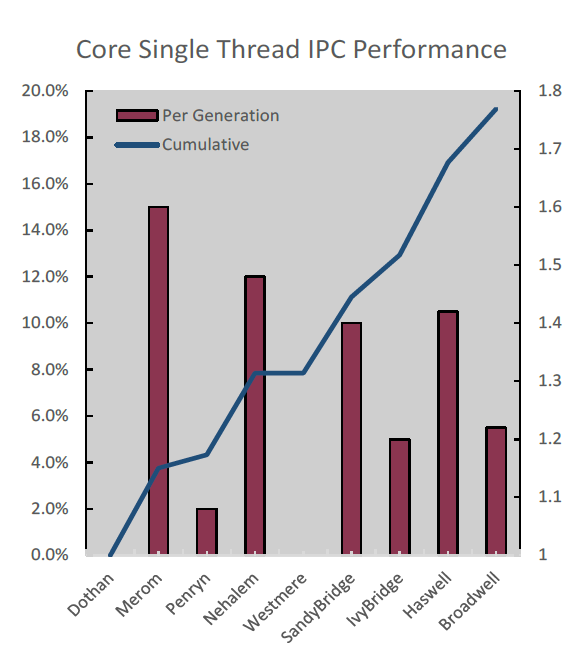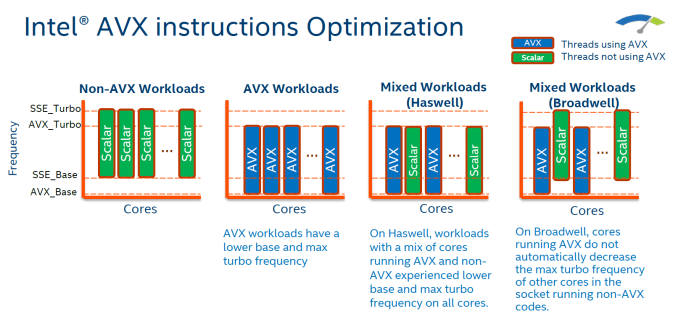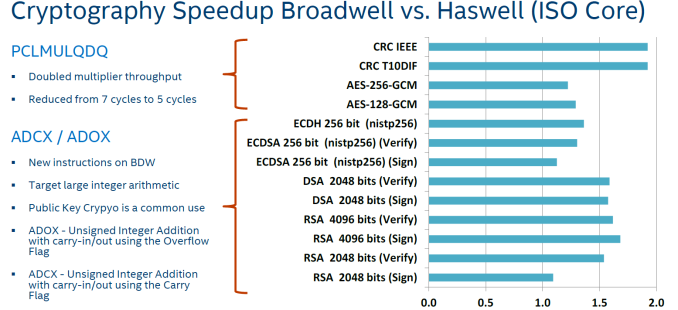The Intel Xeon E5 v4 Review: Testing Broadwell-EP With Demanding Server Workloads
by Johan De Gelas on March 31, 2016 12:30 PM EST- Posted in
- CPUs
- Intel
- Xeon
- Enterprise
- Enterprise CPUs
- Broadwell
A Modest Tick
As Broadwell is a tick - a die shrink of an existing architecture, rather than a new architecture - so you should expect modest IPC improvements. Most Xeon E5 v4 SKUs have slightly lower clockspeeds compared to their Haswell v3 brethren, so overall the single threaded performance has hardly improved. Clock for clock, Intel tells us that their simulation tools show that Broadwell delivers about 5% better performance per clock in non-AVX2 traces.

First Y-axis + bars: simulated single threaded performance improvement. Blue line + second Y-axis is the cumulative improvement.
In that sense, Broadwell is basically a Haswell made on Intel's 14nm second generation tri-gate transistor process. Intel did make a few subtle improvements to the micro-architecture:
- Faster divider: lower latency & higher throughput
- AVX multiply latency has decreased from 5 to 3
- Bigger TLB (1.5k vs 1k entries)
- Slightly improved branch prediction (as always)
- Larger scheduler (64 vs 60)
None of these improvements will yield large performance improvements. The larger improvements must come from other features.
New Features
Compared to Haswell-EP, Broadwell-EP also includes some new features. The first one is the improved power control unit.
On Haswell, one AVX instruction on one core forced all cores on the same socket to slow down their clockspeed by around 2 to 4 speed bins (-200,-400 MHz) for at least 1 ms, as AVX has a higher power requirement that reduces how much a CPU can turbo. On Broadwell, only the cores that run AVX code will be reducing their clockspeed, allowing the other cores to run at higher speeds.
The other performance feature is the vastly improved PCLMULQDQ (carry-less multiplication) instruction: throughput has been doubled, and latency reduced from 7 cycles to 5.
This increases AES (symmetric) encryption performance by 20-25%, and CRCs (Cyclic Redundancy check) are up to 90% faster. Broadwell also has some new ADCX/ADOX instructions to speed up asymmetric encryption algorithms such as the popular RSA. These improvements are implemented in OpenSSL 1.0.2-beta3. But don't expect too much from it.. The compute intensive asymetric encryption is mostly used to initiate a secure connection. Most modern web applications keep their sessions "alive", and as a result, events that require asymmetric encryption happen a lot less frequentely . Symmetric encryption (like AES) which is used to send encrypted data is a lot lighter, so even on a fully encrypted website with long encrypted data streams, encryption is only a small percentage (<5%) of the total computing load.












112 Comments
View All Comments
iwod - Thursday, March 31, 2016 - link
Maximum memory still 768GB?What happen to the 5.1Ghz Xeon E5?
Ian Cutress - Thursday, March 31, 2016 - link
I never saw anyone with a confirmed source for that, making me think it's a faked rumor. I'll happily be proved wrong, but nothing like a 5.1 GHz part was announced today.Brutalizer - Saturday, April 2, 2016 - link
It would have been interesting to bench to the best cpu today, the SPARC M7. For instance:-SAP: two M7 cpu scores 169.000 saps vs 109.000 saps for two of this Broadwell-EP cpus
-Hadoop, sort 10TB data: one SPARC M7 server with four cpus, finishes the sort in 4,260 seconds. Whereas a cluster of 32 PCs equipped with dual E5-2680v2 finishes in 1,054 seconds, i.e. 64 Intel Xeon cpus vs four SPARC M7 cpus.
-TPC-C: one SPARC M7 server with one cpu gets 5,000,000 tpm, whereas one server with two E5-2699v3 cpus gets 3.600.000 tpm
-Memory bandwidth, Stream triad: one SPARC M7 reaches 145 GB/sec, whereas two of these Broadwell-EP cpus reaches 119GB/sec
-etc. All these benchmarks can be found here, and another 25ish benchmarks where SPARC M7 is 2-3x faster than E5-2699v3 or POWER8 (all the way up to 11x faster):
https://blogs.oracle.com/BestPerf/entry/20151025_s...
Brutalizer - Saturday, April 2, 2016 - link
BTW, all these SPARC M7 benchmarks are almost unaffected if encryption is turned on, maybe 2-5% slower. Whereas if you turn on encryption for x86 and POWER8, expect performance to halve or even less. Just check the benchmarks on the link above, and you will see that SPARC M7 benchmarks are almost unaffected encrypted or not.JohanAnandtech - Saturday, April 2, 2016 - link
"if you turn on encryption for x86 and POWER8, expect performance to halve or even less". And this is based upon what measurement? from my measurements, both x86 and POWER8 loose like 1-3% when AES encryption is on. RSA might be a bit worse (2-10%), but asymetric encryption is mostly used to open connections.Brutalizer - Wednesday, April 6, 2016 - link
If we talk about how encryption affects performance, lets look at this benchmark below. Never mind the x86 is slower than the SPARC M7, let us instead look at how encryption affects the cpus. What performance hit has encryption?https://blogs.oracle.com/BestPerf/entry/20160315_t...
-For x86 we see that two E5-2699v3 cpus utilization goes from 40% without crypto, up to 80% with crypto. This leaves the x86 server with very little headroom to do anything else than executing one query. At the same time, the x86 server took 25-30% longer time to process the query. This shows that encryption has a huge impact on x86. You can not do useful work with two x86 cpus, except executing a query. If you need to do additional work, get four x86 xeons instead.
-If we look at how SPARC M7 gets affected by encryption, we see that cpu utilization went up from 30% up to 40%. So you have lot of headroom to do additional work while processing the query. At the same time, the SPARC cpu took 2% longer time to process the query.
It is not really interesting that this single SPARC M7 cpu is 30% faster than two E5-2699v3 in absolute numbers. No, we are looking at how much worse the performance gets affected when we turn on encryption. In case of x86, we see that the cpus gets twice the load, so they are almost fully loaded, only by turning on encryption. At the same time taking longer time to process the work. Ergo, you can not do any additional work with x86 with crypto. With SPARC, it ends up with 40% cpu utilization so you can do additional work on SPARC, and process time does not increase at all (2%). This proves that x86 encryption halves performance or worse.
For your own AES encryption benchmark, you should also see how much cpu utilization goes up. If it gets fully loaded, you can not do any useful work except handling encryption. So you need an additional cpu to do the actual work.
JohanAnandtech - Saturday, April 2, 2016 - link
Two M7 machines start at 90k, while a dual Xeon is around 20k. And most of those Oracle are very intellectually dishonest: complicated configurations to get the best out of the M7 machines, midrange older x86 configurations (10-core E5 v2, really???)Brutalizer - Wednesday, April 6, 2016 - link
The "dishonest" benchmarks from Oracle, are often (always?) using what is published. If for instance, IBM only has one published benchmark, then Oracle has no other choice than use it, right? Of course when there are faster IBM benchmarks out there, Oracle use that. Same with x86. In all these 25ish cases we see that SPARC M7 is 2-3x faster, all the way up to 11x faster. The benhcmarks vary very much, raw compute power, databases, deep learning, SAP, etc etcPhil_Oracle - Thursday, May 12, 2016 - link
I disagree Johan! You don't appear to know much about the new SPARC M7 systems and suggest you do a full evaluation before making such remarks. A SPARC T7-1 with 32-cores has a list price of about $39K outperforms a 2-socket 36-core E5-2699v3 anywhere from 38% (OLTP HammerDB) to over 8x faster (OLTP w/ in-memory analytics). A similarly configured *enterprise* class 2-socket 36-core E5-2699v3 from HPE or Cisco lists for $25K+, so in terms of price/performance, the SPARC T7-1 beats the 2-socket E5-2699v3. And if you take into account SW that’s licensed per core, the SPARC M7 is 60% to 2.6x faster/core, dramatically lowering licensing costs. With the new E5-2699v4, providing ~20% more cores at roughly the same price, gets closer, but with performance/core not changing much with E5 v4, SPARC M7 still has a huge lead. And the difference is while the E5 v3/v4 chips don't scale beyond 2-socket, you can get an SPARC M7 system up to 16-sockets with the almost identical price/performance of the 1-socket system.adamod - Friday, June 3, 2016 - link
BUT CAN IT PLAY CRYSIS?????